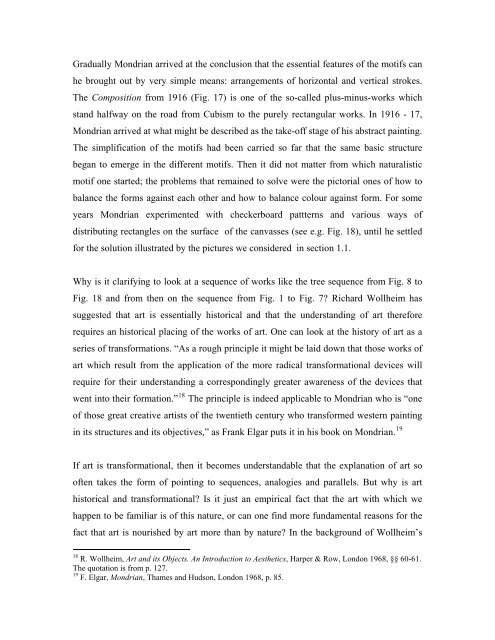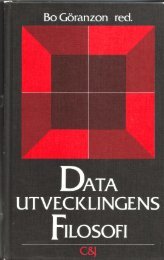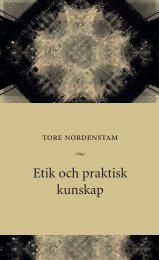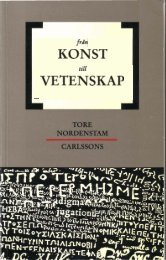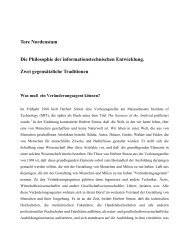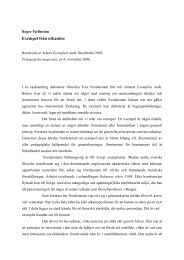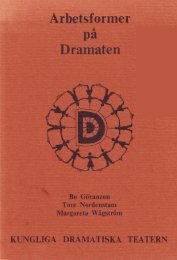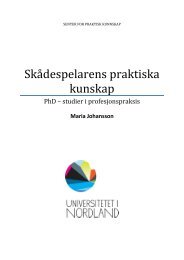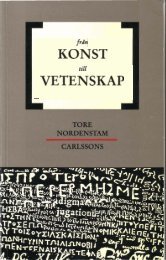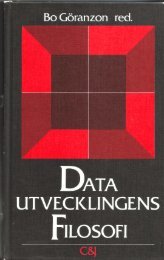tore nordenstam explanation and understanding in the history of art
tore nordenstam explanation and understanding in the history of art
tore nordenstam explanation and understanding in the history of art
You also want an ePaper? Increase the reach of your titles
YUMPU automatically turns print PDFs into web optimized ePapers that Google loves.
Gradually Mondrian arrived at <strong>the</strong> conclusion that <strong>the</strong> essential features <strong>of</strong> <strong>the</strong> motifs can<br />
he brought out by very simple means: arrangements <strong>of</strong> horizontal <strong>and</strong> vertical strokes.<br />
The Composition from 1916 (Fig. 17) is one <strong>of</strong> <strong>the</strong> so-called plus-m<strong>in</strong>us-works which<br />
st<strong>and</strong> halfway on <strong>the</strong> road from Cubism to <strong>the</strong> purely rectangular works. In 1916 - 17,<br />
Mondrian arrived at what might be described as <strong>the</strong> take-<strong>of</strong>f stage <strong>of</strong> his abstract pa<strong>in</strong>t<strong>in</strong>g.<br />
The simplification <strong>of</strong> <strong>the</strong> motifs had been carried so far that <strong>the</strong> same basic structure<br />
began to emerge <strong>in</strong> <strong>the</strong> different motifs. Then it did not matter from which naturalistic<br />
motif one st<strong>art</strong>ed; <strong>the</strong> problems that rema<strong>in</strong>ed to solve were <strong>the</strong> pictorial ones <strong>of</strong> how to<br />
balance <strong>the</strong> forms aga<strong>in</strong>st each o<strong>the</strong>r <strong>and</strong> how to balance colour aga<strong>in</strong>st form. For some<br />
years Mondrian experimented with checkerboard pattterns <strong>and</strong> various ways <strong>of</strong><br />
distribut<strong>in</strong>g rectangles on <strong>the</strong> surface <strong>of</strong> <strong>the</strong> canvasses (see e.g. Fig. 18), until he settled<br />
for <strong>the</strong> solution illustrated by <strong>the</strong> pictures we considered <strong>in</strong> section 1.1.<br />
Why is it clarify<strong>in</strong>g to look at a sequence <strong>of</strong> works like <strong>the</strong> tree sequence from Fig. 8 to<br />
Fig. 18 <strong>and</strong> from <strong>the</strong>n on <strong>the</strong> sequence from Fig. 1 to Fig. 7? Richard Wollheim has<br />
suggested that <strong>art</strong> is essentially historical <strong>and</strong> that <strong>the</strong> underst<strong>and</strong><strong>in</strong>g <strong>of</strong> <strong>art</strong> <strong>the</strong>refore<br />
requires an historical plac<strong>in</strong>g <strong>of</strong> <strong>the</strong> works <strong>of</strong> <strong>art</strong>. One can look at <strong>the</strong> <strong>history</strong> <strong>of</strong> <strong>art</strong> as a<br />
series <strong>of</strong> transformations. “As a rough pr<strong>in</strong>ciple it might be laid down that those works <strong>of</strong><br />
<strong>art</strong> which result from <strong>the</strong> application <strong>of</strong> <strong>the</strong> more radical transformational devices will<br />
require for <strong>the</strong>ir underst<strong>and</strong><strong>in</strong>g a correspond<strong>in</strong>gly greater awareness <strong>of</strong> <strong>the</strong> devices that<br />
went <strong>in</strong>to <strong>the</strong>ir formation.” 18 The pr<strong>in</strong>ciple is <strong>in</strong>deed applicable to Mondrian who is “one<br />
<strong>of</strong> those great creative <strong>art</strong>ists <strong>of</strong> <strong>the</strong> twentieth century who transformed western pa<strong>in</strong>t<strong>in</strong>g<br />
<strong>in</strong> its structures <strong>and</strong> its objectives,” as Frank Elgar puts it <strong>in</strong> his book on Mondrian. 19<br />
If <strong>art</strong> is transformational, <strong>the</strong>n it becomes underst<strong>and</strong>able that <strong>the</strong> <strong>explanation</strong> <strong>of</strong> <strong>art</strong> so<br />
<strong>of</strong>ten takes <strong>the</strong> form <strong>of</strong> po<strong>in</strong>t<strong>in</strong>g to sequences, analogies <strong>and</strong> parallels. But why is <strong>art</strong><br />
historical <strong>and</strong> transformational? Is it just an empirical fact that <strong>the</strong> <strong>art</strong> with which we<br />
happen to be familiar is <strong>of</strong> this nature, or can one f<strong>in</strong>d more fundamental reasons for <strong>the</strong><br />
fact that <strong>art</strong> is nourished by <strong>art</strong> more than by nature? In <strong>the</strong> background <strong>of</strong> Wollheim’s<br />
18<br />
R. Wollheim, Art <strong>and</strong> its Objects. An Introduction to Aes<strong>the</strong>tics, Harper & Row, London 1968, §§ 60-61.<br />
The quotation is from p. 127.<br />
19<br />
F. Elgar, Mondrian, Thames <strong>and</strong> Hudson, London 1968, p. 85.


